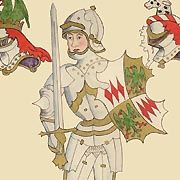This is
episode 24 of my investigation into the life and works of Sir Thomas Malory,
author of Le Morte d’Arthur. Episode 1 can be found here.
P. J. C. Field laments the lack of documentation for Sir
Thomas Malory between December 1457 when he was returned to prison and early
July 1460 when he was finally released.
It may be at the same time that a small, undated amendment was made to
the King’s Bench Controlment Roll:
“acrtam allocatam sine die.”
Malory’s pardon from 1455 was finally allowed. But what was his frame of mind when he was
freed, probably in early July of 1460?
What was his physical and mental condition after years of imprisonment? Had he finished Le Morte d’Arthur sometime in that period? What did he do next? There is no direct
evidence.
But there is another alternative. “When you go looking for something specific,
your chances of finding it are very bad. Because of all the things in the world, you're
only looking for one of them. When you
go looking for anything at all, your chances of finding it are very good.
Because of all the things in the world, you're sure to find some of them,” to
quote Daryl Zero. In that spirit I
decided to carefully consider events of that summer, the actions and locations
of major figures, geography, and, of course, Le Morte d’Arthur itself to see what deductions might be made about
Sir Thomas at that time.
The Earl of Warwick was summoned to Westminster in early
1459 and was personally assaulted in a brawl between men of the King’s
household and his own. The implicit
lawlessness in a palace of state surely shook him. Was it an assassination attempt? There were rumours he was to be imprisoned in
the Tower and he fled to Calais.
When he returned in September for a meeting with York at
York’s castle in Ludow at the edge of the Welsh Marches, a period of rapid escalation
began. The Queen, the King, Edward of
Winchester, Prince of Wales, the Dukes of Somerset and Buckingham had removed
the court to Kenilworth Castle in Warwickshire, where they gathered artillery and
recruited supporters who were given a small badge to show their allegiance and
support: an emblem with a chained swan,
which at that time signified support for the Prince of Wales. Meanwhile Warwick’s father, the Earl of
Salisbury came south with a force of 5,000 and was confronted by a royalist
force under the under the sixty-one year old James Tuchet, Lord Audley at Blore
Heath. Salisbury was victorious and
Audley was killed. The reunion of York,
his family including his eldest son, Edward, Earl of March, Warwick and
Salisbury and their combined forces was perhaps half the size of the Queen’s
forces under Somerset and Buckingham that met them at Ludford Bridge on October
12th. The scale of the
forces, the risks for all, the potential consequences foreshadowed the battle
that would take place at Towton 17 months later. However, that night after a Calais soldier,
Andrew Trollope led 600 to defect to the Queen’s forces, York and his generals
decided their position was untenable and deserted their army and York’s wife
and two youngest sons. York and his son
Edmund, Earl of Rutland fled to the west coast and Ireland, Warwick, Salisbury
and Edward, Earl of March to Devon, Guernsey and finally the relative safety of Calais. In December, at a parliament called at St.
Mary’s Priory in Coventry, the rebels and several others loosely affiliated
with them were attainted, that is stripped of all property, rights and
honours. Later, it came to be known as
the “Parliament of Devils.” Events were
spiraling out of control and predictability. Thomas Malory, though in prison,
must have learned of some if not all of this.
So, what were his thoughts if he heard that Warwick, the Earl of March, Lord Fauconberg had landed with a force of 2,000 at Sandwich on the 26th of the following June, 1460? The force quickly grew to 20,000 or more and marched on London. The city first decided to refuse them entrance and prepared defenses, but when 11 alderman rebelled, they changed their mind. The Bishops of Exeter and Ely met Warwick in Southwark to ensure a peaceful and ordered entrance but there was a great crush on the bridge and 13 men-at-arms were killed. Malory would have heard the noise. Depending on the location of his cell and how high up it was he might have glimpsed what was happening on the bridge.
It was natural that Warwick, Salisbury and the Earl of March freed their supporters, including Malory. That the records of the King’s Bench show also that his pardon was allowed, suggests two things. That someone, probably Malory himself, was taking careful legal advantage of the situation and, not surprisingly given circumstances, that Buckingham’s influence on the Court of the King’s Bench was broken. What, perhaps is most surprising given how far things had devolved, is what happened on July 3rd. In a public ceremony, the earls of Warwick, Salisbury and March took a formal oath on the cross of Canterbury at St. Paul’s, declaring their allegiance to Henry VI. Warwick, himself, then announced that they’d come with their people to declare their innocence or else die in the field.
Whether it was political theatre or an honest declaration it was probably essential in order to be certain of the support of those, like Malory, whose formative years had been spent in the service of Henry V. But those were very different times. The wars then were in France. From Newbold Revel to St. Albans is a distance of 74 miles, to Wakefield 108 miles, 67 miles to Mortimer’s Cross and only 35 miles to Northampton. War had come home to the Midlands.
Malory must have pondered his loyalties and reflected on how he could act both honourably and for the best safety and interest of his family and property. It was natural that he would choose to follow Warwick first, not only because of Fauconberg’s help in procuring bail in 1457. So, what did he do next? Did he ride north with Fauconberg, Warwick and the Earl of March to confront Buckingham with Henry VI at Northampton, did he return home, or did he remain in London. All are possible. But I favor the latter. Before he departed, Warwick began a siege of the Tower of London, still under Lancaster control under Lord Scales, according to one chronicle,
“…They that were within the Tower cast wildfire to the city
and shot in small guns, and burned and hurt men and women and children in the
streets. And they of London laid great
bombards on the further side of the Thames against the Tower and crased the
walls in diverse places.”
Among the relatively few emendations Malory makes in
translating his sources is this one, when Mordred is sieging Guinevere who has
taken refuge in the Tower, “…he layde mighty syge aboute the Towre and made
many assaltis, and threw engynnes unto them, and shotte grete gunnes.” Malory’s decision to color the event with
modern weapons suggests he may have been reflecting on what he himself saw that
July in 1460 and, if so, tells us that he had not yet completed Le Mort d’Arthur in spite of the time
he might have had to do so. Further,
Malory, now around sixty years old, lately out of prison, may not yet have been
fit enough to go on campaign. That he
would stay and aid the siege on the Tower seems most probable.
There is one last possible inference to consider. Why did the Queen, Buckingham and Somerset issue badges with a symbol of the Prince of Wales? Why not the royal heraldry or Lancaster? Perhaps, it reflects that Edward of Winchester’s right of succession was a central issue and utmost in her mind.
Episode 25 can be found here.






No comments:
Post a Comment